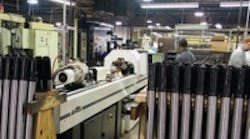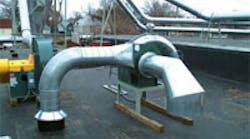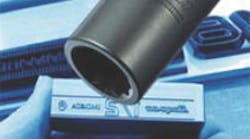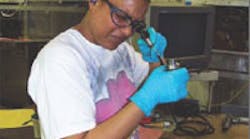U.K.-based Sabre Defense Industries initially launched its U.S. operations in Nashville, Tenn., to produce barrels for XR15/16 rifles, premium variants of the AR15 and M16 rifles. However, the start of the war in Iraq in 2003 changed that. Within a few short years, the demand for large 50-caliber barrels grew from about 100 per month to 1,200 per month, and plant employment jumped from 15 to 85.
Sabre Nashville (www.sabredefense.com) had used a manual lapping machine to finish barrel bores, but the increase in military orders caused a bottleneck of work at that operation. Charles Shearon, general manager of the Nashville plant, realized the solution was to incorporate some current technology that could improve the bore-finishing process and output, so the plant installed an HTB-2000 tube hone system from Sunnen Products Co. (www.sunnen.com).
Equipped with Borazon CBN stones, a traveling steady-rest and whip-guide bushings, the HTB-2000 puts out about 10 to 12 barrels per hour as compared to the old process that did one per hour. "The load-sensing system on the HTB-2000 automatically adjusts the stone feed for optimum stock removal without tool crashes, which reduces our labor and improves output," Garry Hogan, Sabre's plant manager, said. "And more important to us is the automatic gaging system. The machine gages the bore after every stroke, allowing us to control hole size, roundness and straightness to 0.0005 in. without operator intervention. Even after button rifling and plating, we are able to stay well below the MIL-Spec of ±0.004 in. on bore dimensions, which is quite a feat on a bore length of 33 in." Tool life for the process varies with the amount of stock removal, which typically runs 0.002 in. to 0.004 in.
Hogan also said that the crosshatch pattern the honing machine leaves on bore surfaces aids in rifling the barrel by maintaining a consistent lubricant film. To create barrel rifling, a 0.517-in. carbide button pushes through the bore that measures 0.503 in. at this stage. "The extremely round hole we get with the hone helps prevent high and low spots in the rifling and keeps the grooves concentric with the bore, all of which aid accuracy," Hogan said.
The HTB-2000 generates bore surface finishes of approximately 20 µin. Ra. That drops into the teens after button rifling and significantly exceeds the MIL-Spec of 63 µin. Hogan said that in the precision rifle shooting community, the sweet spot for surface finishes is considered 10 µ to 20 µ. Sabre produces two variations of its 50-caliber barrel: a heavy one for the M2 Browning gun and a lighter shorter one for the M3 aircraft machine gun. Both barrel styles get a Stellite liner for their chamber throats and first few inches of rifling.
Heavy-barrel material starts out as a 45-in.-long, 2.625-in.-diameter piece of barstock weighing around 73 lb. The shop does preliminary operations to prep them, then gun-drills the chamber ends to a 0.750-in.-diameter hole that is 11-in. deep. After installing a temporary liner, the shop gun-drills the rest of the barrel to a 0.490-in. diameter and reams the holes to a tolerance of ±0.001 in. Then the barrels are stress relieved, which often changes the bore.
The HTB-2000 allows the shop to control a bore's final geometry and size to a fraction of the allowable MIL-Spec. By holding sizes close at this stage, barrels remain well within spec down the road when the button-rifling process and chrome plating introduce small variations in barrel size.
After contouring barrel exteriors, bores are chrome plated to a thickness of 0.0013 in. to 0.002 in. "One of the reasons we run such tight tolerances of the hone machine is because we lose some tolerance in the plating process," explained Hogan. "The platers are excellent and seldom vary more than 0.0005 in., but if they do, we already have some margin for error to work with."
Sabre gun-drills and reams Stellite liner castings that are then sent to another shop for honing. With barrels induction heated and an alignment gage in place, the shop presses the liners into the barrel chambers so that the liner lands and grooves align perfectly with those of the barrels.








